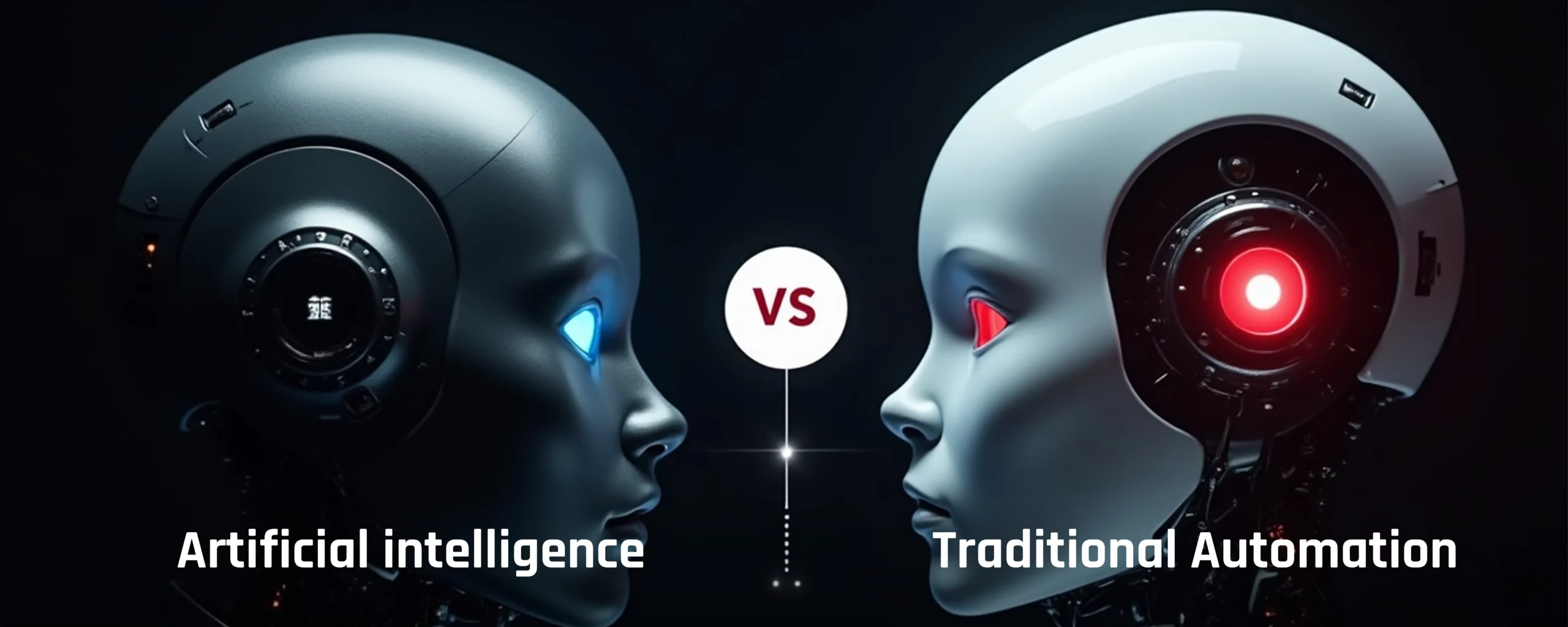AI vs Traditional Automation: The Real Difference Driving Business Efficiency

Automation has helped businesses improve efficiency for decades, but AI has redefined what’s possible. Comparing AI vs traditional automation shows how artificial intelligence is not just automating tasks—it’s transforming how organizations think, act, and grow. According to PwC, AI could boost global GDP by 15% by 2030, proving its potential to redefine productivity at scale.
What Is Traditional Automation?
Traditional automation relies on predefined scripts or rule-based logic to perform repetitive actions. These systems are ideal for structured, predictable processes like invoice generation, payroll management, or assembly line production.
However, traditional automation lacks adaptability. When processes change, systems need manual reconfiguration, which limits scalability. It works best in stable environments but struggles with dynamic, data-heavy operations.
Example: Traditional Automation in Action
- In a logistics company, a traditional system may generate delivery schedules based on fixed rules.
- But if traffic or weather conditions change, the system cannot adapt unless reprogrammed.
What Makes AI Automation Different?
AI automation introduces intelligence and flexibility. It doesn’t just follow rules—it learns from data. AI systems use machine learning (ML), computer vision, and natural language processing (NLP) to make real-time, context-aware decisions.
Example: AI Automation in Action
- In logistics, an AI-driven system dynamically adjusts routes based on weather, delivery priority, and fuel efficiency.
- The system learns continuously, improving accuracy and cost savings over time.
AI automation transforms operations from reactive to predictive, reducing human oversight and enabling autonomous decision-making.
Key Differences Between AI vs Traditional Automation
| Aspect | Traditional Automation | AI Automation |
| Decision-Making | Follows predefined rules | Learns from data to predict and act |
| Adaptability | Limited to fixed logic | Self-improving and dynamic |
| Scalability | Manual updates required | Expands automatically with data |
| Error Handling | Breaks on exceptions | Detects and corrects anomalies |
| Implementation Cost | Lower upfront | Higher initial cost but higher ROI |
AI automation delivers more sustainable long-term efficiency by learning from feedback and adjusting without human input.
Business Benefits of AI Automation
- Smarter Decision-Making: AI systems analyze real-time data to detect trends and optimize workflows. For instance, manufacturers using AI in predictive maintenance report 25% less downtime.
- Cost Optimization: Automating processes with AI reduces operational expenses by 20–40% through better accuracy and resource allocation.
- Faster Execution: AI algorithms perform data-intensive tasks instantly, cutting turnaround times dramatically.
- Personalization: In retail, AI automation helps deliver tailored experiences, improving conversion rates by up to 30%.
Use Cases Across Industries
Finance
AI automates fraud detection, reconciliations, and credit scoring using data patterns that traditional systems can’t interpret.
Healthcare
Hospitals use AI to automate medical imaging and patient triage, improving diagnostic accuracy and speed.
Retail
AI predicts inventory demand and personalizes recommendations, reducing waste and increasing sales.
Manufacturing
Smart factories use AI to monitor production, predict failures, and improve supply chain coordination.
Customer Support
AI chatbots understand natural language and context, offering personalized responses 24/7.
The Enterprise Perspective: Why Transitioning Matters
Large organizations are shifting from rule-based systems to adaptive AI for one reason – scalability. Traditional automation maxes out when business logic gets complex. AI thrives on complexity.
Common Challenges Enterprises Face
- Data Quality Issues: Inconsistent data reduces AI accuracy.
- Integration with Legacy Systems: Older systems are often incompatible with modern AI solutions.
- Talent Gap: Lack of skilled professionals slows implementation.
- Compliance Concerns: Industries like finance and healthcare require explainable AI for audits.
- Change Resistance: Employees fear job loss or technology complexity.
How Enterprises Can Overcome These Challenges
- Start Small, Scale Fast: Pilot AI in one function, like customer service or inventory management.
- Focus on Data Readiness: Invest in cleaning, organizing, and labeling data before deployment.
- Use Explainable AI: Adopt transparent models that meet regulatory standards.
- Train Teams: Equip employees with AI literacy to build trust and collaboration.
- Partner with Experts: Work with experienced providers like Isometrik AI to simplify integration.
Building an AI Automation Roadmap
- Define Goals: Clarify what success means—cost reduction, customer satisfaction, or speed.
- Assess Infrastructure: Evaluate data storage, integration capabilities, and processing power.
- Select Use Cases: Start with high-impact, low-risk processes like document processing or analytics.
- Deploy in Phases: Roll out AI systems department by department to monitor results.
- Measure ROI: Track efficiency, accuracy, and cost improvements consistently.
How Isometrik Bridges AI and Traditional Automation
Isometrik’s intelligent automation platform merges both rule-based and AI-driven automation. It allows enterprises to automate complex workflows without coding, combining predictability with adaptability.
Key features include:
- Seamless integration with existing tools and systems.
- Real-time monitoring and analytics dashboards.
- Self-learning automation that improves with each task.
Companies using Isometrik have reported 40% faster workflow execution and improved process visibility.
Future of Automation: The Hybrid Approach
The future isn’t AI versus traditional automation—it’s AI plus automation. Businesses will combine both to achieve balance. Rule-based systems will handle repetitive and structured tasks, while AI will manage adaptive, data-driven decisions.
By 2030, Gartner predicts that 75% of organizations will deploy hybrid automation frameworks integrating both AI and traditional methods. This approach will ensure flexibility, compliance, and resilience in fast-changing markets.
Conclusion
Understanding AI vs traditional automation helps enterprises plan smarter transformation strategies. Businesses adopting AI-driven automation see faster decision cycles, lower costs, and stronger customer relationships.
Ready to modernize your automation strategy? Partner with Isometrik AI to transition seamlessly from rule-based automation to intelligent, self-learning workflows.